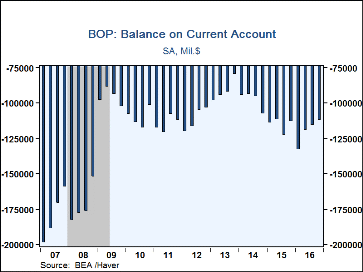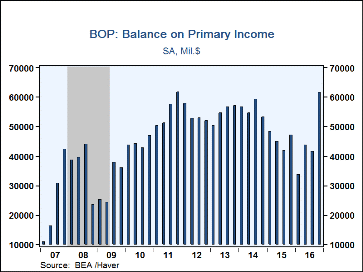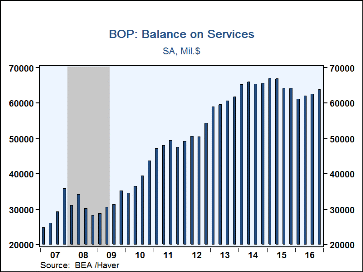 Global| Mar 21 2017
Global| Mar 21 2017U.S. Current Account Deficit Narrows Q/Q, Yet Deepens for the Year
by:Tom Moeller
|in:Economy in Brief
Summary
The U.S. current account deficit declined to $112.4 billion during last year's fourth quarter from $116.0 billion in Q3'16. The Q4 deficit figure compared to $128.2 billion expected in the Action Economics Forecast Survey. The latest [...]
The U.S. current account deficit declined to $112.4 billion during last year's fourth quarter from $116.0 billion in Q3'16. The Q4 deficit figure compared to $128.2 billion expected in the Action Economics Forecast Survey. The latest quarterly deficit was the smallest since Q2'15. For all of last year, the deficit increased to $481.2 billion from $463.0 billion in 2015. As a percent of GDP, the deficit last quarter of 2.4% was less than half the size in late 2006.
The narrowing in the deficit last quarter was due primarily to a near record trade surplus on primary income of $61.5 billion. The deficit on secondary income was stable q/q, but has trended lower. In addition, the surplus on services trade increased to $63.8 billion as exports rose 1.0% and imports increased 0.4%. Nevertheless, the surplus on services trade for the year eased to $249.4 billion as imports rose 2.9% and exports remained little changed. The balance on merchandise trade deepened last quarter to $196.1 billion. Exports eased 0.9% (+1.8% y/y) and imports strengthened 2.5% (2.6% y/y) as oil prices increased. For the year, the merchandise trade deficit eased to $$749.9 billion, its smallest since 2013.
Balance of Payments data are in Haver's USINT database, with summaries available in USECON. The expectations figure is in the AS1REPNA database.
| US Balance of Payments SA | Q4'16 | Q3'16 | Q2'16 | Q4'15 | 2016 | 2015 | 2014 |
|---|---|---|---|---|---|---|---|
| Current Account Balance ($ Billion) | -112.4 | - 116.0 | -119.7 | -113.4 | -481.2 | -463.0 | -392.1 |
| Deficit % of GDP | 2.4 | 2.5 | 2.6 | 2.5 | 2.6 | 2.6 | 2.3 |
| Balance on Goods ($ Billion) | -196.1 | -178.7 | -187.7 | -188.4 | -749.9 | -762.6 | -752.2 |
| Exports | -0.9% | 4.4% | 1.7% | 1.8% | -3.4% | -7.5% | 2.6% |
| Imports | 2.5% | 1.2% | 1.2% | 2.6% | -2.8% | -4.7% | 4.0% |
| Balance on Services ($ Billion) | 63.8 | 62.4 | 62.0 | 64.2 | 249.4 | 262.2 | 262.0 |
| Exports | 1.0% | 2.0% | 0.8% | 2.5% | 0.2% | 1.0% | 6.0% |
| Imports | 0.4% | 2.6% | 0.5% | 4.1% | 2.9% | 1.5% | 4.4% |
| Balance on Primary Income ($ Billion) | 61.5 | 41.6 | 43.8 | 47.1 | 180.6 | 182.4 | 224.0 |
| Balance on Secondary Income ($ Billion) | -41.5 | -41.4 | -37.7 | -36.3 | -161.2 | -145.0 | -125.9 |
Tom Moeller
AuthorMore in Author Profile »Prior to joining Haver Analytics in 2000, Mr. Moeller worked as the Economist at Chancellor Capital Management from 1985 to 1999. There, he developed comprehensive economic forecasts and interpreted economic data for equity and fixed income portfolio managers. Also at Chancellor, Mr. Moeller worked as an equity analyst and was responsible for researching and rating companies in the economically sensitive automobile and housing industries for investment in Chancellor’s equity portfolio. Prior to joining Chancellor, Mr. Moeller was an Economist at Citibank from 1979 to 1984. He also analyzed pricing behavior in the metals industry for the Council on Wage and Price Stability in Washington, D.C. In 1999, Mr. Moeller received the award for most accurate forecast from the Forecasters' Club of New York. From 1990 to 1992 he was President of the New York Association for Business Economists. Mr. Moeller earned an M.B.A. in Finance from Fordham University, where he graduated in 1987. He holds a Bachelor of Arts in Economics from George Washington University.










